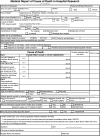Improving hospital death certification in Viet Nam: results of a pilot study implementing an adapted WHO hospital death report form in two national hospitals
- PMID: 28588910
- PMCID: PMC5321316
- DOI: 10.1136/bmjgh-2015-000014
Improving hospital death certification in Viet Nam: results of a pilot study implementing an adapted WHO hospital death report form in two national hospitals
Abstract
Background: Viet Nam does not have a system for the national collection of death data that meets international requirements for mortality reporting. It is identified as a 'no-report' country by the WHO. Verbal autopsy reports are used in the community but exclude deaths in hospitals.
Methods: This project was undertaken in Bach Mai National General Hospital and Viet Duc Surgical and Trauma Hospital in Viet Nam from 1 March 2013 to 31 March 2015. In phase 1, a modified hospital death report form, consistent with the International Statistical Classification of Diseases and Related Health Problems, 10th Revision, was developed. Small group training in use of the report form was delivered to 427 doctors. In phase two, death data were collected, collated and analysed. In phase three, a random sample (7%) of all report forms was checked for accuracy and completeness against medical records.
Findings: During the 23 months of the study, 3956 deaths were recorded. Across both hospitals, 222 distinct causes of deaths were recorded. Traumatic cerebral oedema was the immediate cause of death (15% of cases, 575/3956 patients), followed by septic shock (13%, 528/3956), brain compression (11%, 416/3956), intracerebral haemorrhage (8%, 336/3956) and pneumonia (5%, 186/3956); 67% (2639/3956) of patients were discharged home to die and 33% (1314/3956) of deaths were due to a road traffic accident, or injury at home or at work.
Conclusions: This study confirms the viability of implementing a death report form system compliant with international standards in hospitals in Viet Nam and provides the foundation for introducing a national death report form scheme. These data are critical to comprehensive knowledge of causes of death in Viet Nam. Death data about patients discharged home to die is presented for the first time, with implications for countries where this is a cultural preference.
Conflict of interest statement
Competing interests: None declared.
Figures
References
LinkOut - more resources
Full Text Sources
Other Literature Sources
Miscellaneous


